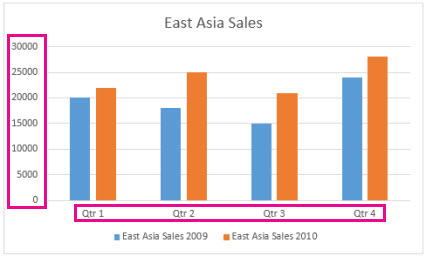
In sum then, my view on what to do with the vertical axis label has changed.

In this case, maybe simply putting a percentage sign next to the top y-axis label would suffice. Of course, if the axis title is short, maybe you just need a callout instead, as the Dallas Morning News describes in their style guide (you can find a selection of other data visualization guides in the Style Guides on my website). The Urban Institute, for example, places the axis label next to the vertical axis ( see the style guide) and the Congressional Budget Office places it just above the vertical axis.īy comparison, the Sunlight Foundation rotates the vertical axis (though, I would argue in the wrong direction) to leave room for an explanatory subtitle. I’ll also note that many places use the Subtitle Title approach, or some variation therein, as their default style.

(Oh, and I just eyeballed the data here). Moving it into the subtitle (and getting rid of the script text) certainly makes it easier to read, and perhaps also faster (you’ll note that I also deleted the 18 percentage signs because the axis titles tell you its percentages). Here’s an example from CityLab where you really do have to turn your head to read this axis. Finally, axis labels are not always short.In fact, in some cases (e.g., Excel) it’s one less “object” to add to your chart because you can include it in the same text box as the chart title. It’s not that much harder to add this label to the chart.(By the way, hat tip to Jen Christiansen and Robert Kosara for finding the Borkin et al paper for me). If the horizontal axis is labeled (or is obvious, such as country names or years), the reader isn’t going to think twice about which axis the Subtitle Title applies. As the authors note, “Across all textual elements the title is among the most important.” Thus, even though the label is further from the axis-though a bit closer when I left-align it with the vertical axis-its location closer to the title makes it more likely people will read it.
#EXCEL 2016 CHART AXIS LABELS SERIES#
In that paper, participants reviewed a series of graphs and were most likely to mention and recall the titles of the graphs. It’s directly linked with the title of the chart, and people tend to read chart titles, as a 2015 paper by Michelle Borkin and her co-authors showed.In this case, Naomi wrote that, “The placement on the left figure more clearly associates the label with the axis while the placement on the right is easier to read….It’s six of one and half dozen of the other.”įor a long time, I adopted Naomi’s position: The “Rotated Title” works fine, is close to the axis, and is the default, so why mess with it? But lately I’ve been thinking that the Subtitle Title approach is superior for three primary reasons: (You’ll note I’ve also left-aligned both the title and axis label). With longer axis labels, however, this can be more difficult to read-more on this in a moment.įinally, the bottom-right chart takes the axis label and inserts it as a subtitle to the chart-let’s call this the “Subtitle Title” (terrible name, I know). This label is relatively easy to read and is compact within the entire graph space. The bottom-left chart is the usual default axis label-Excel calls this the “Rotated Title” (though, honestly, if it’s the default, shouldn’t it just be called the “Title”?). Here again, Naomi and I are in agreement. The label in the top-right chart-what Excel calls a “Horizontal Title”-is easier to read, but it takes up a lot of unnecessary space. Naomi called this “unacceptable” and I agree. Even with a short title like “Percent” you can’t really read it. The label in the top-left chart-what Excel calls a “Vertical Title”-is, well, ridiculous. In it, she explores four options for the vertical axis label (I’m using the same chart style and layout as Naomi, but with different data). One of the articles that informed my original views was this 2013 post by Naomi Robbins. For the most part, axis labels tend to be short, so it’s not like you have to turn your head to read them.
#EXCEL 2016 CHART AXIS LABELS SOFTWARE#
Most default software programs rotate the vertical axis label 90 degrees, and I never really thought that was too big of a deal. It seems like a simple, basic aspect of data visualization design.

One of the early data visualization best practices I was interested in learning more about was how and where to place my vertical axis labels.


 0 kommentar(er)
0 kommentar(er)
